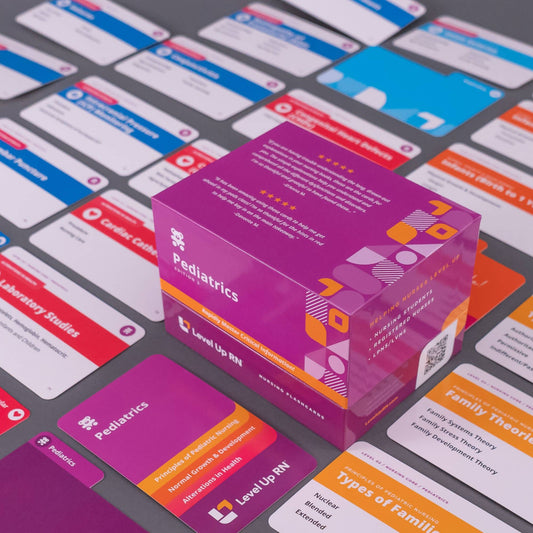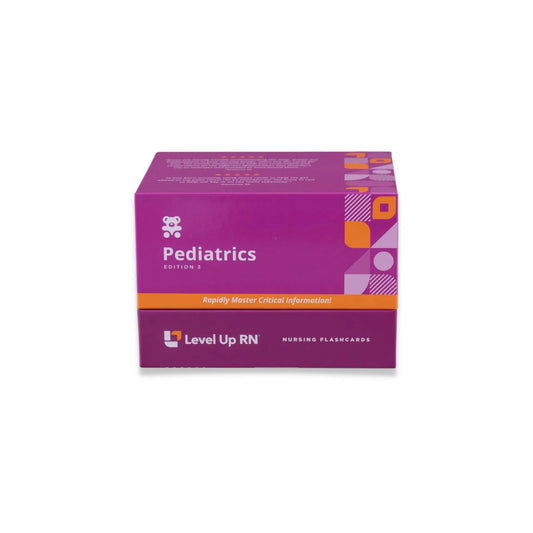Pediatric Nursing - Flashcards
This article discusses normal growth and development and expected milestones for preschoolers (children between four and six years of age).
The Pediatric Nursing series follows along with our Pediatric Nursing Flashcards, which are intended to help nurses and nursing students learn and retain information about caring for pediatric patients. The flashcards are a clear, complete study tool and a helpful reference for practicing RNs, PNs, and other medical professionals.
 When you see this Cool Chicken, that indicates one of Cathy's silly mnemonics to help you remember. The Cool Chicken hints in these articles are just a taste of what's available across our Level Up RN Flashcards for nursing students!
When you see this Cool Chicken, that indicates one of Cathy's silly mnemonics to help you remember. The Cool Chicken hints in these articles are just a taste of what's available across our Level Up RN Flashcards for nursing students!
Physical growth and development milestones for preschoolers
At this point in their development, preschoolers start to level out their rate of growth from the more intense growth rates that they had when they were infants and toddlers.
As with toddlers, weight, height, gross motor skills, and fine motor skills are among the most common physical growth and development milestones for preschoolers.
Weight expectations for preschoolers
Preschoolers are expected to gain about four to six pounds per year.
Height expectations for preschoolers
Preschoolers grow about three inches per year.
Gross motor skills in preschoolers
Gross motor skills refers to big movements using big muscles.
By age three, preschoolers should be able to ride a tricycle — the pedaling motion is a noteworthy gross motor skill. Preschoolers should be able to balance on one foot and jump off of a bottom step, that is, jumping from one height to a lower height.
At four years, preschoolers should be able to hop on one foot, catch a ball, and skip.
At five years, preschoolers should be able to jump rope and use roller skates.
Fine motor skills in preschoolers
Fine motor skills refers to small movements, using small muscles. Over the next few years, we see the same concepts and ideas becoming more and more complex in how a preschooler achieves them.
At three years, preschoolers should be able to draw a circle, and they can draw a face. They can’t yet draw a complete stick figure, but they are able to draw a circle with some facial features.
At age four, preschoolers should be able to use safety scissors. This is a complex motion. They will also start to add three parts to their stick figure drawings, and they should be able to draw a square. Remember from the toddler video previously, children first learn to draw circles, then squares, then triangles — from the simple to the more complex. You can remember this order is alphabetical: C, S, T.
Age five, preschoolers should be able to tie their shoelaces, draw a diamond and a triangle, and add seven to nine parts to a stick figure.
Cognitive development in preschoolers: the preoperational stage
In terms of cognitive development, preschoolers are now in the preoperational stage. This is the second stage in Piaget’s Theory of Cognitive Development, a theory that describes perception and cognition across a person’s lifespan.
Language development in preschoolers
In terms of language development, preschoolers should now have telegraphic speech, which means using two-to-four-word sentences. For instance, sentences that include a noun and verb.
Preschoolers also ask lots of questions, especially “Why?” They are trying to learn more about the world around them. Although this can become repetitive and exhausting for the parent, caregivers need to know that this persistent questioning is normal.
Normal behaviors for preschoolers
The following are other normal behaviors in preschoolers.
Animism
Animism is when we attribute human characteristics to inanimate objects. A preschooler will exhibit this normal behavior with a stuffed animal or a doll. They might attribute a thought or a feeling to the stuffed animal or doll; they may talk to it, too.
Magical thinking
Magical thinking is defined as thinking that magic is real, and that things can happen in the child’s environment because of magic. This is the stage where children start to believe in the Tooth Fairy, for example, and in the idea that “I can kiss it and make it better,” where the child believes that kissing a wound will magically heal it.
A preschooler may think that they can make events happen — for good or ill — based on their thoughts. This is reflected in a young child’s perception of death. For example, if a parent is terminally ill, the preschooler might think, “I caused mommy to get sick because I had bad behavior,” or, if it is the child who has a serious illness, they might think they are being punished for their behavior: “I behaved badly and it will cause my death.”
Egocentrism
Egocentrism is the inability to see someone else’s perspective. This is normal in preschoolers. Note their focus on themselves when they are little — it's always “I, I, I.”
Incomplete concept of time
Preschoolers have an incomplete concept of time. That is, if the parent tells their child they are going to have dinner at 6:30 p.m., the child will have no idea what that means. But they do understand the concept of dinner, and that dinner happens in the later part of the evening and before bed. So adults often use cues to help a child understand something temporal. For instance, if the parent wants to communicate to their child when they are going to go to the park, they say, “We're going to go to the park after the baby’s nap” and not “at two o’clock.” This use of cues helps the preschooler to better understand the relationship of space and time.
Psychosocial Development in preschoolers: initiative vs. guilt
Initiative vs. guilt is one of Erikson’s Stages of Psychosocial Development — a theory that describes key stages in human development and the “psychosocial crisis” encountered during each stage. From 3 to 6 years of age, children take initiative in the world and assert themselves through their social and physical interactions. Basically, they want to do things on their own.
Age-appropriate play for preschoolers
Associative play
Associative play is when children play together, but without too much organization.
Dramatic play
Dramatic play is where children play-pretend. They might act out scenes from movies or cartoons. They might want to dress up or play “house,” including the use of props to act out normal life activities.
Toys
In addition to dressing up, preschoolers like simple games, puzzles, dolls, and puppets.
Nutrition for preschoolers — what parents should know
In terms of nutrition for preschoolers, we start to move on from the very specific and structured guidance for nutrition that was so important for infants and toddlers.
Quality of food vs. quantity of food
At this point in the child’s development, the quality of food is more important than the quantity consumed. This means rather than having a certain amount of food served at each meal, it is more important to give preschoolers a variety of good-quality food — meats, vegetables, grains, fruits, etc. Note that preschoolers will tend to eat what they want to eat (rather than what the parent wants them to eat).
Food portions for preschoolers
In terms of food portions for preschoolers, this is approximately half that of an adult serving.
5-2-1-0 framework
The 5-2-1-0 framework is a way to remember: the servings of fruits and vegetables preschoolers should get per day (5), how much screen time they should have per day (no more than 2 hours), how many hours of physical activity they should get per day (at least 1 hour), and the amount of sugar-sweetened beverages they should consume daily (zero). These are guidelines; they won’t always be followed strictly.
Sleep requirements for preschoolers
A preschooler should get about 12 hours of sleep at night, and it is (still) important to maintain a consistent bedtime routine.
Preschooler vaccination schedule
 My preschooler is afraid of the dark, so I keep the lights Very DIM.
My preschooler is afraid of the dark, so I keep the lights Very DIM.
From four to six years, children are vaccinated with more live virus vaccines. These include varicella, DTaP, IPV, MMR. They should also continue to receive an annual influenza vaccine.
Varicella
Varicella is a herpes virus that causes chickenpox and shingles (a viral infection that causes a painful rash).
DTaP
DTaP is a combined vaccine for diphtheria (a highly contagious bacterial disease), tetanus (a serious disease of the nervous system caused by a toxin-producing bacterium), and pertussis (whooping cough).
IPV
IPV is the polio vaccine.
MMR
MMR is the abbreviation for the combined vaccine for measles (an infectious viral disease causing fever and a red rash on the skin), mumps (a contagious disease caused by a virus whose symptoms include swollen salivary glands and a fever), and rubella (German measles).
Note: The charts on our Pediatric Nursing Flashcards are a handy way to get to know the pediatric vaccination schedule for young and older children.


